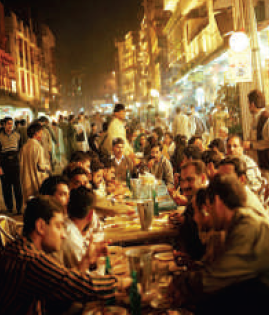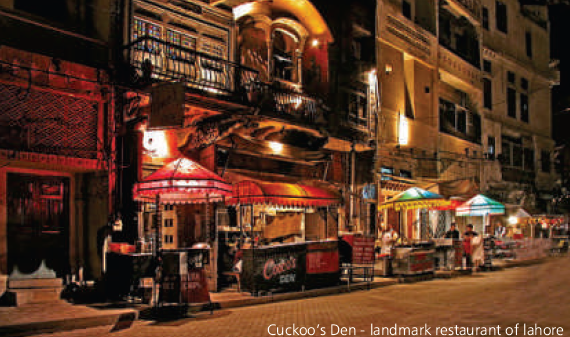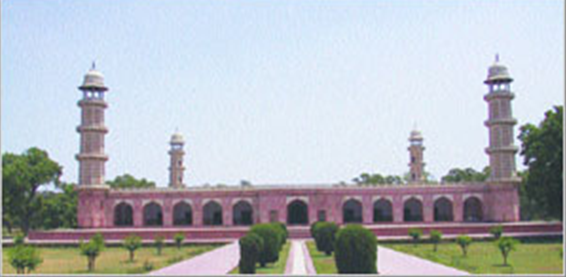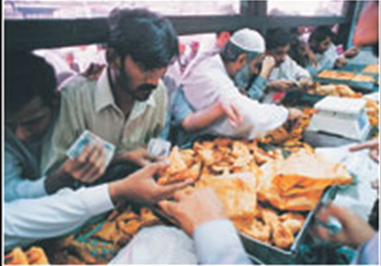Lahore: F-K
This is a collection of articles archived for the excellence of their content. Readers will be able to edit existing articles and post new articles directly |
Contents[hide] |
Food Street
May 06, 2007
REVIEWS: Food lovers’ paradise
Reviewed by Fouzia Mapara
Shazia Iftikhar may have been born in Karachi but she is a ‘Lahori’ at heart. Her book is a delight for anyone who loves Lahore and the delectable culinary delights that the city has to offer to the glutton as well as the gourmet. The book covers a fair bit for tourism. Its unusually interesting accounts and recipes would pull anyone to Food Street.
Those familiar with Lahore are aware of how deep-rooted the city’s historical and traditional values are. Today it is becoming a fast-paced, modern metropolis with slick stores and impressive malls in sharp contrast to the winding old streets lined with little houses that share connecting walls amid the hustle bustle of the mystical gates.
In an attempt to endorse her views on Lahore, the author quotes Tahir Lahori, “Lahore’s weather being conducive to a healthy, happy lifestyle, no wonder the people of Lahore enjoy good food, are well-dressed and happen to be great singers.”
The book features various delights of the Food Street including Afghani tikka, raan roast, fry chaanp, Lebanese tandoori fish, Phajjay ke paye, fried batair, chargha fry masala, kali mirch wali handi, taka tak (kata kat in Karachi); you name it and it’s there.
The book, a treat for food lovers, packages Food Street recipes in a simple format with full-page, coloured, mouth-watering pictures.
The book is inspired by people living abroad, who once visited Food Street and went back to distant lands, battling with continuous experimentation to achieve the magical flavours that they had once tasted.
So for all those who long to revisit, Food Street ke Zaiqe will transport you to the heart of Lahore with its quaint balconies, kahwa cups, the atmosphere aromatic with saag being cooked; it is a different world out there. This is your chance to cook up the delights to perfection without having to go through self-employed ways and means to achieve the taste once experienced at Food Street. It gets even better when you can have the real taste at your own table without having ever gone to Food Street. Either way, it is not a bad deal.
The author vividly writes the food culture of the city giving the reader maximum vicarious delights and sketching picturesque scenes of a vibrant lifestyle where crowds break into “ballay ballay” to celebrate wedding festivities, triumph over a kite captured in the blue skies, or a victory over a cricket match.
There is also a historical account of Lahore, the city being the cultural seat with its tree-lined boulevards and beautiful parks. In the morning you may see streams of people running on jogging tracks after which they may opt for a hearty breakfast of lassi, halwa puri, paye, kulchay and more.
The Food Street, which was inaugurated on October 20, 2000, is located in Gowalmandi. The book portrays the evolution of Gowalmandi from an area inhabited by milkmen supplying milk to the British and other foreigners during the British Raj. Eventually the milkmen and their cattle moved out but the settlement retained its original name and food lovers still flocked to Gowalmandi for fried fish and harissa.
Food Street ke Zaiqe celebrates the 200m-long Food Street with nearly 40 shops on each side, out of which about 15 sell other stuff but the rest focus solely on gastronomic fare.
It is frequented by 5,000-6,000 people everyday and no less than 10 to 15 thousand people at the weekends. It is amazing how the busy street during the day is shut for traffic precisely at 7:00pm to transform into a humongous dining room with tables and chairs laid all over.
Cuisine offered here grew from the little places known to a die-hard Lahorite. For instance, ice cream at Beadon Road and Yaseen’s halwa puri to fuel the Lahorite passion for a hearty breakfast. The author writes about Gowalmandi’s harissa and trips to Dabbi Bazaar for Maula ki mash ki daal, chikar chholey, chargha, batair, succulent barbeque meats and the unforgettable Phajjay ke paye.
The book offers innovative recipes like doodh gosht and various types of stuffed parathas. If you are not content with the kunna gosht and the regular karahi or boneless karahi is not exciting enough, for the more adventurous palate, there is jungli karahi made with a bit of game like batair, venison along with regular chicken and mutton, for the special taste of hunting. There are even recipes for how Russian Salad, coleslaw and burgers taste on Food Street. For the sweet-toothed, there is a variety of recipes on halwas, mithais and firni. All in all, the book offers substantial value in its 130 pages.
Food Street ke Zaiqay
By Shazia Iftikhar
Waleed Publishers.
E-5 Civil Aviation Authority, Gulberg III, Lahore
Tel: 042-5850296
ISBN 969-9055-00-6
130pp. Rs225
Food Streets: part II
India Harmony Volume - 2 : Issue - 1, 2013
Lahore is a foodie's delight and it would be a folly ask anybody how much food he can consume. Guests who have loaded themselves with sandwiches and junk food to their fill, are often asked to accompany the host for “food” , for, in Lahore food means “Khaba” and not “Khana”. Traditionally, Gawalmandi and Mazang are the two main places frequented by visitors and where there is a glut of every kind of food.
Although the three food streets in Lahore (one each at Gawalmandi, Anarkali and the “area” adjacent to the Badshahi Mosque/ Lahore Fort complex ) are the most popular haunts frequented by people for gastronomic delights, there are several other places too frequented by the city's denizens.
There are many names associated with the traditional foods in Lahore, like Phajjay kay Paye ( anyone with the name of Fazal is called Phajja in Punjabi), Bundu Khan (renowned in Karachi for Parathas and kebabs, but now equally well known in Lahore for his traditional oil rich foods of Lahore), Butt Karahi (located on the main McLeod Rd near Lakhshami Chowk – a place well known for the offices of distributors of Pakistani Films), and Ashiq's Channay is a well known desi food outlet located in the main Sadar bazar area inside Lahore cantonment – famous for its channa (chickpeas) curry and haleem (mixed pulses curry). Shahi Murgh Channay in front of the old Odeon Cinema on Abott Road (off Lakhshami Chowk) is perhaps the best in town and one of my favourite spots whenever I am in Lahore and even my children too are very fond of his specialty dish.
Equally good is Ghulam Rasool Restaurant, Nila Gumbad (off Anarkali Bazaar), which also specializes in Murgh Channay. Amritsar Harrisa at Nisbat Road, just in between Lakhshami Chowk and Gawalmandi is best known for Harrisa. Tabbaq Restaurant, Lakshmi Chowk and Paradise canteen, State Life Building, Mall road, are eateries where one can gorge on Mutton Roast and Murgh Musallam (Chicken cooked with rice and dry fruits stuffed inside). Cuckoo's Den is famous for is its Art Gallery and Restaurant situated in the Old City, owned and operated by Pakistan's famous artist Iqbal Hussain. With amazing food and views of the Fort and Badshahi Masjid it is one of the best restaurants in the City. The “Ultay tawa wala Chicken” is perhaps their best dish. The walled city of Lahore is a foodie's paradise, where cooks still provide mouthwatering delicacies. Haji's Nihari inside Lohari Gate is the best, where one can be guaranteed a sumptuous repast. For “decent” eating, M M Alam Road, Gulberg and H-Block Defence Housing Authority (DHA) are the two areas choc-a-bloc with restaurants serving modern Chinese and exotic food dishes.
Fort
Ranjit Singh, Maharaja, sculpture of
June 28, 2019: The Times of India

From: June 28, 2019: The Times of India
See graphic:
Sculpture of Maharaja Ranjit Singh
A life-size sculpture of Maharaja Ranjit Singh, who ruled over Punjab for close to 40 years in the early 19th century, was unveiled on Thursday at the historic Lahore Fort in Pakistan on his 180th death anniversary. It took eight months to complete the 8-ft-tall statue of the Sikh ruler sitting on his favourite horse Kahar Bahar. The sculpture, funded by UK-based Sikh Heritage Foundation, was installed at the Sikh Gallery of the Mai Jindan Haveli in Lahore Fort during a special ceremony attended by senior Pakistani officials
General Post Office
The Post-Colonial Hangover
Text By Issam Ahmad And Photos By Ayesha Vellani
Built alongside the YMCA building in 1887 to commemorate Queen Victoria's Golden Jubilee, the imposing yet elegant arches of Lahore’s General Post Office (GPO) represent a prime example of colonial era Indo-Saracenic architecture.
It blends British, Hindu and Mughal design elements, and took its current shape when it was established as the Post Office, replacing the telegraph office of Anarkali Bazaar. According to eminent Lahorite Majid Sheikh, the bell from the original building was taken from it and transplanted in the GPO for continuity’s sake and as a symbol of good luck. The GPO's inauguration coincided with the unveiling of clock towers and monuments throughout India.
Nadeem Ahsan, current Chief Post Master, says: “The GPO brings forward a tradition of grandeur as one of the traditional beautifying flanks of Mall Road”, alongside the Lahore High Court, the Punjab University, Kim’s cannon, the National College of Arts and the Town Hall.
The building consists of two main halls and two minarets, as well as the commemorative stamps bureau responsible for promoting Pakistani culture, heritage, flora and fauna. It is the largest post office in Pakistan, handling a daily average of 20,000 deliveries per day with a staff of 3000. On token tax and pension payment days, the number of visitors can swell to 5000.
Though steeped in tradition, Pakistan Post is not oblivious to the needs of modernity and recently implemented an automated counter system enabling all customers to make use of services from one counter.
According to Ahsan, the advent of the Internet age saw a “small decline” in the volume of private mail, though with the increase in commercial mail the Post Office remains a revenue generating department.
The GPO was also the site of one of the worst suicide bomb attacks to hit the city of Lahore when on Jan 10 this year, a bomb ripped through GPO Chowk, disrupting a lawyer’s rally and killing 25 people. Fragments of the suicide bomber’s body were later found on the upper portions of the GPO though the building itself suffered little structural damage.
In addition to mail services, the GPO also deals with Baitulmal (charitable) programmes. It is lit-up yearly on August 14 and on October 9, World Post Day, the flag of the Universal Postal Union is hoisted alongside the national flag as part of they day’s celebrations.
Jehangir’s Tomb
Jehangir’s Tomb: a reminder of Mughal glory
By Sehar Sheikh
A few days ago, I read the term ‘the Pakistani Mughal’ for the emperor Jehangir in a paper. He was termed as ‘Pakistani’ Mughal because of all the six great Mughals, i.e. Babar, Humayun, Akbar, Jehangir, Shah Jehan and Aurangzeb, only Jehangir is buried in Pakistan. The historical city of Lahore has the privilege of having Jehangir’s mausoleum; the great Mughal Emperor ruled the sub-continent from 1605 to 1627.
It is believed that Jehangir is in fact prince Salim, the most romantic Mughal prince who had fallen in love with Anarkali, a dancing girl in the Mughal court.
Akbar’s son, Emperor Jehangir, is buried in the magnificent Shahdara Mausoleum near the Lahore Fort. It was Jehangir’s last wish to be buried in Dilkusha Garden of his beloved wife Noor Jehan in Lahore. Noor Jehan’s dark and crumbling tomb also lies in the shadow of her husband’s mausoleum, as she had wished for.
Jehangir’s tomb is considered as the most magnificent structure in sub-continent after Taj Mahal and Qutub Minar. It was designed by Empress Noor Jehan in 1627 who also designed her own and her brother Asif Khan’s tombs. After her husband’s death, Noor Jehan had permanently shifted to Lahore and influenced the design and construction of the mausoleum. It took 10 years to build the tomb and 10 lakh rupees were spent on its construction.
The image of Jehangir’s tomb is also printed at the backside of old 1,000-rupee note of Pakistan.
The mausoleum has four minarets and is situated in a garden full of lush green grass and bushes. Each of these four minarets is 30-metre high and the garden is walled. There are two enormous gateways that lead to the square enclosure known as Akbar Serai. On the west of this enclosure is another area that gives full view of the garden in front of the monument. From the centre of the garden, four parterres proceed which are further subdivided into 16 divisions by means of a brick geometric pavement flanking narrow water channels. Originally there were many enchanting fountains in the four narrow canals which have almost ruined now due to negligence by the department of archaeology.
As you enter the passage from the west which leads to the grave, the corridors and inner sanctuary overwhelms you with splendid mosaic on white marbled walls, floors and ceilings. Not an inch is left unembellished with floral mosaic or Quranic verses. The beautifully laid sarcophagus is screened by a panel of five marble jalis (latticed screen, usually with an ornamental pattern constructed through the use of calligraphy and geometry). The gravestone reads, “Illumined grave of His Majesty, Asylum of Pardon: Emperor Nur-ud-din Muhammad Jehangir, 1037 AH”.
The fourth Mughal Emperor, Jehangir, was very fond of gardens, rivers, lakes, flowers and animals. He had a multitude of rare flowers, birds and animals. He mentions about his love and collection of birds and animals in his memoir Tuzk-e-Jehangiri as well. No doubt his mausoleum has lost a big part of its beauty owing to the passage of time yet it’s a beautiful place that reminds us of the grandeur of our great Muslim rulers.
Kamran’s Baradari
Kamran’s Baradari
By Sehar Sheikh
Lahore is situated at the bank of River Ravi. Ravi and the ancient walled city have hundreds of years old association. Hundreds of tales are related to river Ravi. Ravi used to be the pride of the city. Lahoris would come for a picnic at the river side and struggling with the ores, they would row their boats in the river.
Times have changed and so has the charm of Ravi. Now, this river is nothing more than a drain of wastewater from the city. Right in the centre of the Ravi, there is a monument that was once a popular picnic point. It is known as Kamran’s Baradari.
Mirza Kamran was the first Mughal Governor of Lahore. He was the son of Mughal Emperor Babur and step brother of Humayun. In 1527, Kamran laid out a beautiful garden at the right bank of River Ravi. ‘Bara’ means 12 and ‘dar’ means door. Thus baradari was a 12-door monument that was a part of this garden and used to serve as a recreational spot for Mughal kings. They would visit the place in a boat and enjoy the beautiful scenery. River changed its flow so now baradari is situated almost in the midst of River Ravi while the gardens have deteriorated.
When I was young, I used to visit this place quite often with my family. A bridge is built near baradari that connects Lahore with Shahdara. It is from this bridge that stairs come down to the river bed. A number of boatmen were present there with their decked up boats to take the visitors to the baradari. These boats were and still are traditional boats with ores. Only a few motor boats are available here. But as the journey from the river bank to the baradari is short, I prefer enjoying it in a traditional boat.
As you reach baradari, you find a simple structure built of massive brick masonry. It consists of an octagonal central chamber with four corner octagonal rooms. The walls are simple and plain and do not contain any floral designs painted on them. In fact, just like walls of public colleges, walls of the baradari are like a public whiteboard for visitors to pent out their frustration. So, on these walls you will find all sorts of written messages ranging from political views of the visitors to the drawings of arrows piercing a heart with initials of the beloved written alongside. Water chambers and small-sized fountains are built around the monument to give the place a calm look. Since last two decades, a shrine of a sufi has been established at the back side of baradari. A handful of visitors are found in and around the shrine. There is a small canteen to entertain the visitors.
Kamran’s Baradari was basically built for Mughal Emperors to enjoy the view of the river. It is the only place in Lahore from where you can enjoy the river’s beauty. However, Ravi remains dry for most part of the year. It is only during the monsoon that the river attains its flow and a large number of visitors come here to enjoy the river side.
The present Punjab government has plans to install a water treatment plant on Ravi. If the plan is carried out, it is expected that the beauty of the river will be restored and thus that of baradari too. But prior to that, Kamran’s Baradari is a nice place to visit during the monsoon season.
See also
Lahore: A-E Lahore: F-K Lahore: L-Q Lahore: R-Z Lahore: architectural treasures Lahore: Civic issues Lahore: History Lahore: Parsi cusine Lahore: Protected Monuments Bhai Ram Singh









